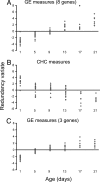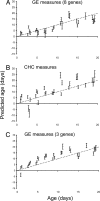The use of transcriptional profiles to predict adult mosquito age under field conditions
- PMID: 17110448
- PMCID: PMC1838706
- DOI: 10.1073/pnas.0604875103
The use of transcriptional profiles to predict adult mosquito age under field conditions
Abstract
Age is a critical determinant of an adult female mosquito's ability to transmit a range of human pathogens. Despite its central importance, relatively few methods exist with which to accurately determine chronological age of field-caught mosquitoes. This fact is a major constraint on our ability to fully understand the relative importance of vector longevity to disease transmission in different ecological contexts. It also limits our ability to evaluate novel disease control strategies that specifically target mosquito longevity. We report the development of a transcriptional profiling approach to determine age of adult female Aedes aegypti under field conditions. We demonstrate that this approach surpasses current cuticular hydrocarbon methods for both accuracy of predicted age as well as the upper limits at which age can be reliably predicted. The method is based on genes that display age-dependent expression in a range of dipteran insects and, as such, is likely to be broadly applicable to other disease vectors.
Conflict of interest statement
The authors declare no conflict of interest.
Figures


Similar articles
-
Field validation of a transcriptional assay for the prediction of age of uncaged Aedes aegypti mosquitoes in Northern Australia.PLoS Negl Trop Dis. 2010 Feb 23;4(2):e608. doi: 10.1371/journal.pntd.0000608. PLoS Negl Trop Dis. 2010. PMID: 20186322 Free PMC article.
-
Improved accuracy of the transcriptional profiling method of age grading in Aedes aegypti mosquitoes under laboratory and semi-field cage conditions and in the presence of Wolbachia infection.Insect Mol Biol. 2011 Apr;20(2):215-24. doi: 10.1111/j.1365-2583.2010.01059.x. Epub 2010 Nov 28. Insect Mol Biol. 2011. PMID: 21114562
-
Aedes (Stegomyia) aegypti in the continental United States: a vector at the cool margin of its geographic range.J Med Entomol. 2013 May;50(3):467-78. doi: 10.1603/me12245. J Med Entomol. 2013. PMID: 23802440
-
Sexual chemoecology of mosquitoes (Diptera, Culicidae): Current knowledge and implications for vector control programs.Parasitol Int. 2017 Apr;66(2):190-195. doi: 10.1016/j.parint.2016.09.010. Epub 2016 Sep 28. Parasitol Int. 2017. PMID: 27692501 Review.
-
Genetic control of mosquitoes: population suppression strategies.Rev Inst Med Trop Sao Paulo. 2012 Sep-Oct;54(5):287-92. doi: 10.1590/s0036-46652012000500009. Rev Inst Med Trop Sao Paulo. 2012. PMID: 22983293 Review.
Cited by
-
Evaluation of diffuse reflectance spectroscopy for predicting age, species, and cuticular resistance of Anopheles gambiae s.l under laboratory conditions.Sci Rep. 2023 Oct 28;13(1):18499. doi: 10.1038/s41598-023-45696-x. Sci Rep. 2023. PMID: 37898634 Free PMC article.
-
Human probing behavior of Aedes aegypti when infected with a life-shortening strain of Wolbachia.PLoS Negl Trop Dis. 2009 Dec 15;3(12):e568. doi: 10.1371/journal.pntd.0000568. PLoS Negl Trop Dis. 2009. PMID: 20016848 Free PMC article.
-
Rapid identification of mosquito species and age by mass spectrometric analysis.BMC Biol. 2023 Jan 24;21(1):10. doi: 10.1186/s12915-022-01508-8. BMC Biol. 2023. PMID: 36690979 Free PMC article.
-
Using body size as an indicator for age structure in field populations of Aedes aegypti (Diptera: Culicidae).Parasit Vectors. 2022 Dec 22;15(1):483. doi: 10.1186/s13071-022-05605-z. Parasit Vectors. 2022. PMID: 36550576 Free PMC article.
-
Complexity of virus-vector interactions.Curr Opin Virol. 2016 Dec;21:81-86. doi: 10.1016/j.coviro.2016.08.008. Epub 2016 Aug 28. Curr Opin Virol. 2016. PMID: 27580489 Free PMC article. Review.
References
-
- Siler JF, Hall MW, Hitchens AP. Philipp J Sci. 1926;29:1–304.
-
- Watts DM, Burke DS, Harrison BA, Whitmire RE, Nisalak A. Am J Trop Med Hyg. 1987;36:143–152. - PubMed
-
- Gilles HM, Warrell DA. Essential Malariology. London: Arnold; 2002.
-
- Dye C. Annu Rev Entomol. 1992;37:1–19. - PubMed
-
- Detinova TS. WHO Monograph No. 47. Geneva: World Health Org; 1962. - PubMed
Publication types
MeSH terms
LinkOut - more resources
Full Text Sources
Other Literature Sources
Medical

